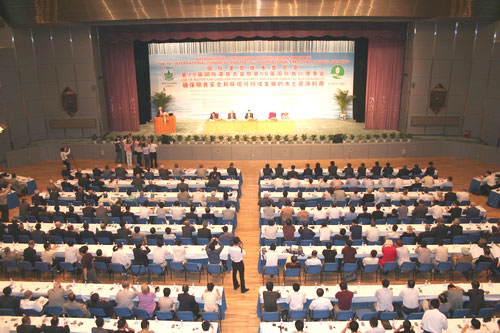
Water, received from precipitation and stored behind dams for irrigation may have the following drawbacks:
- High evaporation loss.
- Soil erosion in the catchment resulting in siltation and reduced storage capacity.
- Environmental impact of surface reservoirs.
- Expensive distribution system because of the distance between dam and utilization areas.
In contrast, groundwater is not exposed to evaporation; does not suffer from reduction of storage capacity because of siltation; is seldom harmful to environment and offers a natural water distribution up to the users.
When looking at these advantages and disadvantages, groundwater seems to be a better alternative that should be preferred, but this not the case; large and concentrated water demand such as that from large irrigation schemes is usually supplied from surface water storage, and there are various reasons for that choice:
- Groundwater aquifers seldom offer large storage capacity to be able to absorb large volumes of flood in a short period of time, and are unable to return them as significant discharge per unit production system of well or borehole.
- Surface water storage, because of the large investments involved, is often preferred because it offers a much higher political visibility and because high construction costs give an opportunity for private profit, opening the way for improper influence on decision making.
Conjunctive use: Conjunctive use of surface and groundwater consists of harmoniously combining the use of both sources of water in order to minimize the undesirable physical, environmental and economic effects of each solution and to optimize the water demand/supply balance.
Assuming that the mixed solution is part of the national policy, several problems need to be carefully studied before selecting the different options and elaborating a programme of conjunctive use of surface and groundwater:
- Underground storage availability to be determined,
- Production capacity of the aquifer(s) in term of potential discharge,
- Natural recharge of the aquifer(s)
- Induced natural recharge of the aquifer(s)
- Potential for artificial recharge of the aquifer(s)
- Comparative economic and environmental benefits derived from the various possible options.
Related items you may like






















Irrigation
Sources of Irrigation
Irrigation History +
Sources of Irrigation +
IMPROVING SOIL MOISTURE +
Ponds +
Tanks +
Diversion Weirs +
Dams and Reservoirs +
Groundwater +
Conjunctive Water Use +
Wastewater +
Poor Quality Water +
Application of Irrigation water
Canal Irrigation +
Flood Irrigation +
Deficit Irrigation +
Supplemental Irrigation +
Sprinkler Irrigation +
Drip Irrigation +
Lift Irrigation +
Centre Pivot Irrigation +
Tidal Irrigation +
Micro-Irrigation Technologies for Small Holders +
Automatic Irrigation Systems +
Pressurized Irrigation +
Irrigation in Viticulture +
Purpose of Irrigation
Instruments and implements of Irrigation
Pumps +
Centrifugal Pumps +
Submersible Pumps +
Turbine and Jet Pumps +
Conveying Pipes +
Sprinklers +
Drippers +
Canal Automation Systems +
Irrigation Management
Economics of Irrigation System +
I&D System Types +
I&D Investment Functions +
I&D Management Issues +
Participatory I&D Management +
Equity in Irrigation +
Irrigation Services +
Irrigation and environment
Pollution and Irrigation +
Irrigation and Climate Resilience +
Environmental Aspects of Irrigation +
Environmental Impacts of Irrigation +
Green Lawn Irrigation +
Safe Use of Waste Water in Irrigation +
Organic Agriculture +
Soil Health +
Soil Health Management +
Quality of Irrigation Water +
Capacity Development
Drainage
Drainage Types and Systems
Agricultural Drainage +
Field Drainage systems +
Canal Irrigation and Drainage +
Surface Drainage Systems +
Subsurface Drainage +
Mole Drainage +
Bio-Drainage +
Regional Bio-Drainage +
Drainage Issues
- Surface water hydrology
- Geohydrology, Hydrogeology or Groundwater hydrology
- Subsurface ice, or Interstitial ice
- Interflow, Subsurface runoff
- Subsurface flow, or Underground flow
- Groundwater runoff
- Groundwater storage
- Groundwater province
- Subsurface water, Underground water, or Subterranean water
- Groundwater
- Capillary groundwater, or Fringe water
- Groundwater table
- Free groundwater, Phreatic water, or Non-artesian water
- Confined water, or Confined groundwater
- Perched water, or Perched groundwater
- Semiperched groundwater
- Fixed groundwater
- Attached groundwater
- Groundwater flow
- Groundwater reservoir
- Groundwater artery
- Groundwater divide
- Isopiestic line, or Pressure surface contour
- Pressure surface map
- Piezometric surface, or Pressure surface
- Water-table contour, or Groundwater contour
- Groundwater cascade
- Groundwater dam
- Groundwater ridge
- Interstream groundwater ridge
- Groundwater mound, or Groundwater hill
- Groundwater trench
- Groundwater withdrawal, or Groundwater extraction
- Water surface (groundwater)
- Phreatic surface
- Effective velocity (of groundwater), Actual velocity (of groundwater), True velocity (of groundwater), or Field velocity (of groundwater)
- Apparent velocity (of groundwater)
- Average velocity (of groundwater)
- Critical velocity (of groundwater )
- Groundwater turbulent flow
- Groundwater recharge
- Groundwater balance, or Groundwater budget
- Groundwater increment, or Groundwater accretion
- Groundwater decrement
- Groundwater inventory
- Groundwater equation
- Groundwater management
- Groundwater model
- Groundwater balance
- Groundwater basin
- Potentiometric surface
- Water surface slope
- Surface float
- Subsurface float
- Surface water
- Surface acre
- Surface tension
- Surface tension
- Surface bend, or Free bend
- Topsoil, or Surface soil
- Surface curves
- Surface area of reservoir, or Maximum water surface area
- Water surface
- Normal water surface elevation, Normal water level, Conservation water level, Storage level, Normal pool level, or Conservation storage level
- Control house
- Composite surface of failure
- Critical circle, or Critical surface
- Line of seepage, or Phreatic surface
- Hydroelectric power house, Power house building, or Power house superstructure
- Valve chamber, or Valve house
- Fuse plug, or Breaching section
- Fusegates
- Hydraulic rollers, Circular roller, Elliptical roller, Vertical roller, Horizontal roller, Inclined roller, Submerged roller, or Surface roller
- Surface type fixed-wheel gate
- Friction drag, Skin friction, or Surface drag
- Top width, or Surface width
- Natural surface line
- Natural surface level, or Ground levels
- Transition-curve length, Transition face length, Transition surface length, or Curved transition length
- Causeway
- Straight (line, surface) sharp cut-water, Equilateral cut-water, or Sixty degree straight sharp cut-water
- Groundwater conservation
- Groundwater mining
- Groundwater overdraft
- Block system (a term used in India in the States of Maharashtra and Gujarat)
- Groundwater storeys
- Observation well, Groundwater station, Monitor well, or Piezometer
- Free surface
- Equipotential surface
- Seepage surface
- Depleted pressure surface
- Depleted phreatic surface, or Depleted water table
- Isobath of the piezometric surface
- Fluctuation of the piezometric surface
- Cycle of the piezometric surface fluctuation
- Prospecting (groundwater)
- Pump house
- Diffuser, or Diffuser vanes
- Irrigation from groundwater
- Sailab irrigation (a term used in India and Pakistan)
- Surface irrigation
- Recycling system, Reuse system
- Diffuser (fixed)
- Distribution pattern (of a sprinkler diffuser)
- Range (of a sprinkler or diffuser)
- Minimum operating pressure (of a sprinkler or diffuser)
- Test pressure (of a sprinkler or diffuser)
- Mini-diffusers
- Surface drip irrigation
- Mini-diffusers
- Surface filtration
- Surface runoff
- Consumptive water use or Consumptive use
- District consumptive use
- Optimum consumptive use
- Seasonal consumptive use
- Effective water use
- Non-beneficial consumptive use
- Groundwater table
- Crop water use efficiency or Crop water use index
- Irrigation water use efficiency
- Level of satisfaction of the water requirement of users
- Surface water
- Subsurface drainage system
- Surface drainage
- Surface drains
- Groundwater table
- Horizontal subsurface drainage system
- Surface inlet
- Surface-cum-seepage drains
- Subsurface drainage, Under drainage, Subsoil drainage, Underground drainage, or Covered drainage
- Subsurface drain, Under drain, Covered drain, or Buried drain
- Field surface drain
- Surface drainage system
- Free surface
- Phreatic surface
- Piezometric surface
- Subsurface run-off
- Surface flow
- Surface runoff
- Vertical subsurface drainage system
- Surface retarders
- Surface moisture, or Free moisture
- Smoothing cement, or Surfacer paint
- Surface dressing, or Surface treatment
- Pump house, or Pumping station
- Multi-use bit
- Safety fuse
- Pricing - Users` fees
- Users Training
- User fees
- Surface erosion
- Surface sealing (of soil)
- Surface creep
- Land-use-capability classes
- Waste water re-use
- Non‑consumptive use
- Greenhouse effect
- Refuse
- Organic refuse
- Inorganic refuse
- Surface dump
- Groundwater contamination
- Direct reuse
- Reuse
- Indirect reuse
- Anti‑degradation clause
- Surface irrigation
- Surface water problem
- Water‑gathering surface
- Water neutral surface
- Water‑spreading surface
- Groundwater flooding
- Fuseplug levee
- Floodplain land use planning
- Houses and structures raising
- Multiuser
- User-friendly program
- Mouse
- Conjunctive irrigation planning
- Recreational uses of water
- Land-use pattern
- Agricultural water use
- Artificial groundwater recharge
- Groundwater system, or Groundwater basin
- Kanat, Foggara, Karez (used in Baluchistan), Rhettara (used in Morocco), or Qanat (used in Iran)
- Land use
- Surface water body
- Groundwater investigations, or Geohydrological investigations
- Subsurface geology
- Use of facilities method
- Ceiling allocation, or Priority of use method
- User charge
- Greenhouse Effect
- Greenhouse Gas






